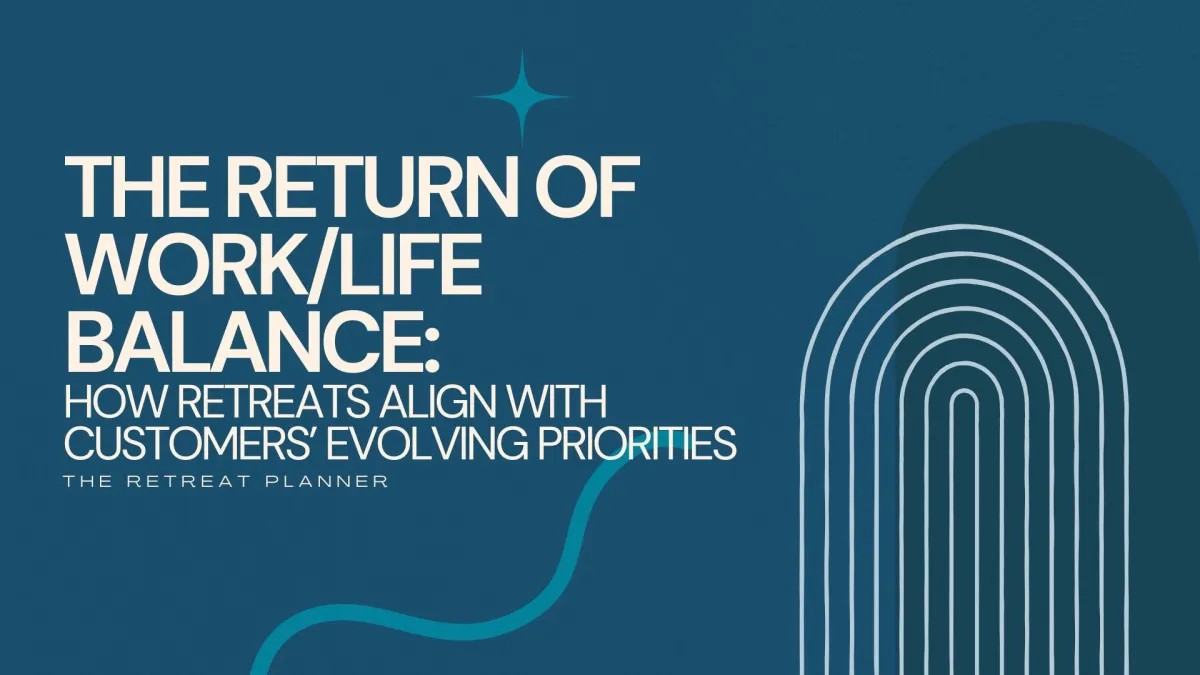How To Run Profitable Retreats Blog

The Return of Work/Life Balance: How Retreats Align with Customers’ Evolving Priorities
“The Return of Work/Life Balance: How Retreats Align with Customers’ Evolving Priorities"

In an age where burnout is on the rise, the desire for work/life balance has never been more pressing. Today’s customers aren’t just looking for products or services—they’re seeking solutions that respect their time and energy while delivering meaningful value. For retreat leaders, this shift represents a powerful opportunity to align with your audience’s priorities and position your offerings as a sanctuary of simplicity and renewal.
Let’s explore how the return of work/life balance is reshaping customer expectations and how retreats can meet this growing demand.
Why Work/Life Balance Matters More Than Ever
The modern customer is fiercely protective of their time, energy, and mental bandwidth. A Deloitte study reveals that 77% of workers have experienced burnout at their current jobs, driving a cultural shift toward prioritizing personal well-being over professional demands. This shift means:
Time is the new currency: Customers are more selective about how they spend their time and energy.
Value trumps cost: Simplicity, alignment with values, and long-term benefits outweigh financial considerations.
Experiences matter: Customers seek opportunities to disconnect from daily stress and reconnect with themselves.
Retreats are uniquely positioned to address these priorities, offering immersive experiences that provide both renewal and transformation
How Retreats Align with the Demand for Work/Life Balance
Retreats are a natural fit for customers prioritizing work/life balance. Here’s how:
1. Time to Disconnect and Reconnect
Retreats create space for participants to step away from the demands of work and daily life, offering a rare chance to focus on personal well-being.
Example: A mindfulness retreat in a serene location allows attendees to unplug from their devices and reconnect with nature and themselves.
2. Simplified Experiences
By handling all the details—from accommodations to curated activities—retreats eliminate decision fatigue and make relaxation effortless.
Example: A fully planned wellness retreat with guided meditations, spa treatments, and healthy meals provides participants with a stress-free escape.
3. Long-Term Value
Retreats are more than a getaway; they offer tools and practices that participants can integrate into their daily lives for sustained benefits.
Example: A yoga retreat that includes workshops on building a consistent at-home practice delivers value far beyond the event itself.
4. Emotional and Mental Renewal
Attendees leave retreats feeling recharged, reconnected, and ready to tackle their lives with greater clarity and balance.
Example: A leadership retreat designed for busy professionals combines rest with skill-building sessions that reignite passion and purpose.
Marketing Retreats in the Era of Work/Life Balance
To connect with today’s balance-conscious customers, your marketing must reflect their priorities. Here’s how:
1. Highlight Time and Energy Savings
Emphasize how your retreat simplifies decision-making and planning, giving participants a seamless experience.
Message Idea: “Step into a space where everything is taken care of—all you need to do is show up and unwind.”
2. Showcase Simplicity and Value
Focus on the transformative benefits your retreat offers, rather than the logistics or price.
Message Idea: “Rediscover balance with a retreat that nourishes your mind, body, and soul.”
3. Share Stories of Transformation
Use testimonials and case studies to demonstrate how your retreat helps participants achieve work/life harmony.
Message Idea: “After our retreat, I felt like I finally had the tools to manage stress and prioritize what truly matters.”
4. Offer Flexible Options
Provide shorter retreats or virtual components for clients who may not be ready to commit to a week-long event.
Example: A weekend reset retreat or a virtual mindfulness workshop series.
Positioning Your Retreats for the Balance-Seeking Audience
Here’s how to ensure your retreats resonate with customers prioritizing work/life balance:

Curate Intentional Schedules: Balance structured activities with downtime to honor the need for rest and reflection.
Offer Post-Retreat Support: Provide resources or follow-ups to help attendees integrate their learnings into daily life.
Create Spaces for Connection: Design activities that foster genuine community and support among participants.
Take the Next Step
Are you ready to align your retreat business with the growing demand for work/life balance? By emphasizing simplicity, renewal, and long-term value, your retreats can become a sanctuary for those seeking harmony in a busy world.
Book a call with me today, and let’s craft a retreat experience that resonates with today’s balance-conscious customers. Together, we’ll design offerings that inspire and empower your audience to reclaim their time and energy.
With love,
Leni


